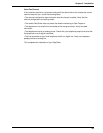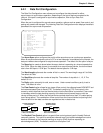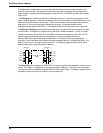
69
Chapter 6 - Menus
6.2.2 Sync Data Port Configuration
The Data Port Configuration menu allows you to configure the data channel for either
asynchronous or synchronous operation, depending on the type of device connected to the
channel.
When the port is configured for synchronous operation, the following Data Port Configuration
menu displays the default parameters:
Data Port Configuration
1 - Async/Sync: Sync
2 - Speed: 19200
3 - Clocking: Internal
4 - Idle Condition: Flags
5 - NRZ/NRZI Encoding: NRZ
6 - CRC Preset: All 1s
7 - Inter-frame Timer: Off
S -
Store All Configuations
M - Main Menu
P - Previous Menu
Selection : _
The Async/Sync option configures the port for either asynchronous or synchronous operation.
When a synchronous device such as a LAN bridge or router is connected to the channel, the
data port needs to be configured for synchronous operation.
The Speed option needs to be set when the sync device is operating at a channel speed other
than 19.2k. When the data channel is connected to a synchronous device, the channel baud rate
is from 300 bps up to 128K bps. The default channel speed is 19.2k bps.
The Clocking option needs to be set for either internal or external clocking. When the DataTalker
is providing the clocking, the option needs to be set for internal clocking. When clocking is
provided by the synchronous device, this option must be set for external clocking. The default for
the clocking option is internal clocking.
The Idle Condition option must be set to match the idle condition of the synchronous device
connected to the data port. The idle condition must set when the synchronous data line is in an
idle condition (i.e., no data frames are being transmitted). The default condition is to continuously
send SDLC flags (Flags). The other idle condition is the mark state (Mark). The transmit LED
will be off during idle time if the synchronous device is in the mark state during idle conditions.
The NRZ/NRZI Encoding option refers to the fact that synchronous data can be encoded by
using either the NRZ (Non-Return to Zero) or NRZI (Non-Return to Zero Inverted) method. This
option must match the synchronous device’s encoding. The default is NRZ. Most synchronous
devices are configurable. If a synchronous device is not configurable, it is set to NRZ. Refer to
the device’s user documentation for the encoding method.
The CRC Preset option allows the user to specify whether the polynomial used to calculate the
CRC for each frame is present to all 1s or all 0s. This option must match the synchronous
device’s CRC setting. The default is All 1s.
The Inter-frame Timer option can be changed to make the DataTalker wait a specified length of
time between frames being transmitted on the data channel. The user can choose delay times of
2,5,10 and 15 milliseconds. A typical use for this parameter is to simulate transmission delays
encountered with equipment that toggles hardware signals after transmission of each frame, like
PC cards used to connect to legancy systems. The following options can be specified for the
timer: Off, 2mS, 5mS, 10mS, and 15mS. The default is off.


















